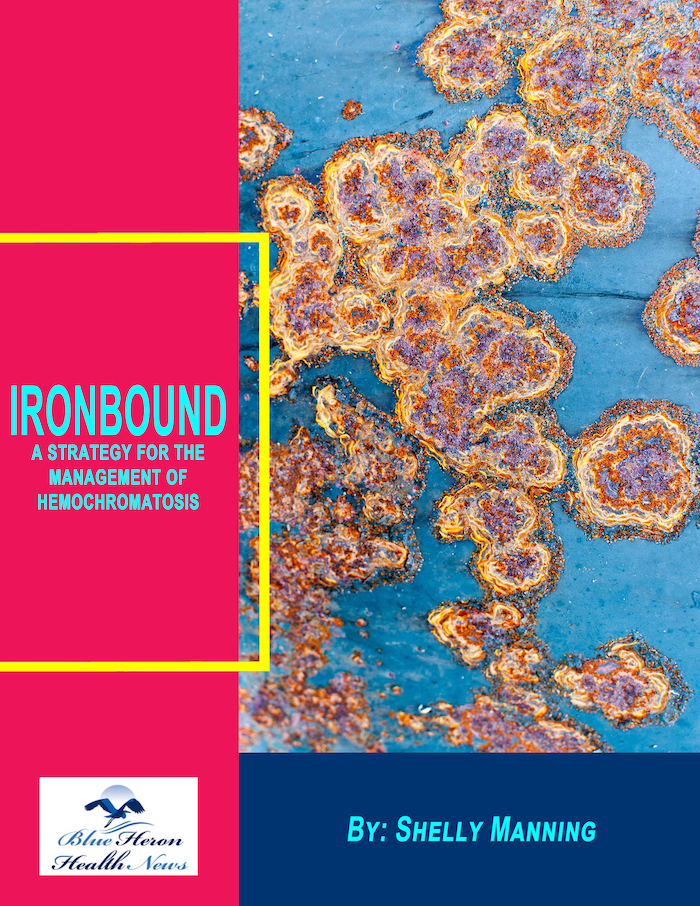
Ironbound™ A Strategy For The Management Of Hemochromatosis By Shelly Manning The 5 superfoods explained by Shelly Manning in this eBook play an important role in reducing the levels of HCT. The absorption of the excessive amount of iron by the genes of HCT can be blocked by these superfoods. In this way, the information provided in this eBook can help in resolving the problem of excess iron in your body naturally without any risk of side effects.
What causes hemochromatosis?
Comprehensive Guide to the Causes of Hemochromatosis
Hemochromatosis is a genetic disorder that leads to excessive absorption and accumulation of iron in the body. This condition can result in iron overload, causing damage to various organs and tissues. Understanding the causes of hemochromatosis, particularly the genetic and secondary factors, is crucial for diagnosis, treatment, and management. This comprehensive guide explores the underlying causes of hemochromatosis.
1. Overview of Hemochromatosis
1.1 Definition
- Hemochromatosis: A condition characterized by the excessive absorption and storage of iron in the body. It is mainly a genetic disorder but can also result from other medical conditions or environmental factors.
1.2 Types of Hemochromatosis
- Hereditary Hemochromatosis (HH): The most common form, caused by genetic mutations.
- Secondary Hemochromatosis: Resulting from other conditions or factors that cause iron overload.
- Juvenile Hemochromatosis: A rare, severe form that manifests in childhood or adolescence.
- Neonatal Hemochromatosis: A rare condition with rapid iron buildup in a newborn’s liver and other tissues.
2. Genetic Causes of Hereditary Hemochromatosis
2.1 HFE Gene Mutations
2.1.1 Common Mutations
- C282Y Mutation: The most common mutation in the HFE gene associated with hereditary hemochromatosis. Individuals who are homozygous for this mutation (having two copies) are at high risk of developing the condition.
- H63D Mutation: Another mutation in the HFE gene. Individuals who are compound heterozygous (having one C282Y and one H63D mutation) are also at risk, though typically with milder symptoms.
2.1.2 Mechanism
- Iron Regulation: The HFE gene is involved in regulating iron absorption. Mutations in this gene impair the body’s ability to regulate iron uptake from the diet, leading to excessive iron absorption and storage.
2.2 Other Genetic Mutations
2.2.1 Transferrin Receptor 2 (TFR2)
- TFR2 Mutations: Mutations in the TFR2 gene can cause a less common form of hereditary hemochromatosis, known as type 3 hemochromatosis.
2.2.2 Hepcidin (HAMP)
- HAMP Mutations: Hepcidin is a key hormone in iron regulation. Mutations in the HAMP gene can lead to juvenile hemochromatosis, characterized by early-onset iron overload.
2.2.3 Ferroportin (SLC40A1)
- SLC40A1 Mutations: Mutations in the ferroportin gene can cause type 4 hemochromatosis (ferroportin disease), which involves impaired iron export from cells, leading to iron buildup.
3. Secondary Causes of Hemochromatosis
3.1 Chronic Liver Diseases
- Chronic Hepatitis C: Chronic infection with hepatitis C virus can lead to increased iron absorption and secondary iron overload.
- Alcoholic Liver Disease: Chronic alcohol consumption can cause liver damage and increase iron absorption.
- Nonalcoholic Steatohepatitis (NASH): A form of fatty liver disease that can also be associated with increased iron stores.
3.2 Hemolytic Anemias
- Thalassemia: A genetic blood disorder causing chronic hemolysis (breakdown of red blood cells), leading to increased iron absorption and secondary hemochromatosis.
- Sickle Cell Disease: Another hemolytic anemia that can lead to increased iron absorption due to frequent red blood cell destruction.
3.3 Multiple Blood Transfusions
- Transfusion-Dependent Anemias: Conditions like beta-thalassemia major and myelodysplastic syndromes often require regular blood transfusions, leading to iron overload as the body lacks a mechanism to excrete excess iron.
3.4 Other Medical Conditions
- Porphyria Cutanea Tarda: A condition affecting heme production in the liver, often associated with iron overload.
- Hereditary Spherocytosis: A genetic disorder causing red blood cells to be more fragile and break down easily, leading to increased iron absorption.
4. Environmental and Lifestyle Factors
4.1 Dietary Iron Intake
- High Iron Diet: Consuming large amounts of dietary iron, particularly heme iron from red meat, can contribute to iron overload, especially in individuals with genetic predispositions.
- Iron Supplements: Excessive use of iron supplements can also lead to iron overload in susceptible individuals.
4.2 Alcohol Consumption
- Alcohol and Iron Absorption: Chronic alcohol consumption can increase iron absorption and exacerbate iron overload in individuals with hemochromatosis.
5. Pathophysiology of Iron Overload
5.1 Iron Absorption and Regulation
- Normal Regulation: Iron absorption in the intestine is tightly regulated by hepcidin, a hormone produced by the liver that inhibits iron absorption when body iron stores are sufficient.
- Disruption in Regulation: In hemochromatosis, mutations in genes involved in iron regulation (e.g., HFE, HAMP, TFR2) lead to reduced hepcidin production or activity, resulting in excessive iron absorption despite adequate or elevated body iron stores.
5.2 Iron Storage and Toxicity
- Iron Storage: Excess iron is stored in various organs, including the liver, heart, pancreas, and joints.
- Toxic Effects: Iron can generate free radicals through the Fenton reaction, causing oxidative damage to cells and tissues. This oxidative stress leads to inflammation, fibrosis, and organ damage over time.
6. Diagnosis of Hemochromatosis
6.1 Medical History and Physical Examination
- Family History: Assessing family history for hemochromatosis or related conditions.
- Physical Examination: Checking for signs of organ damage, skin discoloration, or joint abnormalities.
6.2 Blood Tests
- Serum Ferritin: Elevated levels indicate increased iron stores.
- Transferrin Saturation: Measures the percentage of transferrin (a protein that carries iron) that is saturated with iron. Levels above 45% may indicate iron overload.
- Liver Function Tests: Assessing liver function and damage.
6.3 Genetic Testing
- HFE Gene Testing: Identifying mutations in the HFE gene (C282Y and H63D) to confirm hereditary hemochromatosis.
- Other Genetic Tests: Testing for mutations in other relevant genes (TFR2, HAMP, SLC40A1) if HFE mutations are not present.
6.4 Imaging and Biopsy
- MRI: Magnetic resonance imaging can assess iron accumulation in the liver and other organs.
- Liver Biopsy: A sample of liver tissue is examined to assess the extent of iron overload and liver damage.
7. Treatment and Management
7.1 Phlebotomy
- Regular Blood Removal: The primary treatment for hereditary hemochromatosis is phlebotomy (therapeutic blood donation). Removing blood reduces iron levels as the body uses stored iron to produce new red blood cells.
- Frequency: Initially, weekly phlebotomy may be required until iron levels normalize, followed by maintenance phlebotomy every few months.
7.2 Chelation Therapy
- Iron Chelators: For patients who cannot undergo phlebotomy, medications like deferoxamine, deferasirox, or deferiprone can bind to iron and help remove it from the body.
7.3 Dietary Management
- Limit Iron Intake: Avoiding iron-rich foods, supplements, and vitamin C supplements (which increase iron absorption).
- Avoid Alcohol: Reducing alcohol intake to prevent liver damage.
- Balanced Diet: Maintaining a healthy diet to support overall health without excessive iron.
8. Monitoring and Prevention
8.1 Regular Monitoring
- Iron Levels: Frequent blood tests to monitor iron levels and organ function.
- Liver Surveillance: Regular imaging and tests to monitor for liver damage or cancer.
8.2 Genetic Counseling and Screening
- Family Planning: Genetic counseling for individuals with a family history of hemochromatosis to understand the risk of passing the condition to offspring.
- Screening: Screening for family members to identify those at risk and initiate early intervention.
9. Conclusion
Hemochromatosis is primarily caused by genetic mutations that disrupt the body’s ability to regulate iron absorption, leading to excessive iron accumulation and potential organ damage. Secondary hemochromatosis can result from other medical conditions or environmental factors. Early diagnosis and effective management are crucial to prevent complications and improve outcomes. Understanding the causes and mechanisms of hemochromatosis helps in developing targeted therapies and personalized treatment plans, ultimately enhancing the quality of life for individuals affected by this condition.
Ironbound™ A Strategy For The Management Of Hemochromatosis By Shelly Manning The 5 superfoods explained by Shelly Manning in this eBook play an important role in reducing the levels of HCT. The absorption of the excessive amount of iron by the genes of HCT can be blocked by these superfoods. In this way, the information provided in this eBook can help in resolving the problem of excess iron in your body naturally without any risk of side effects.
